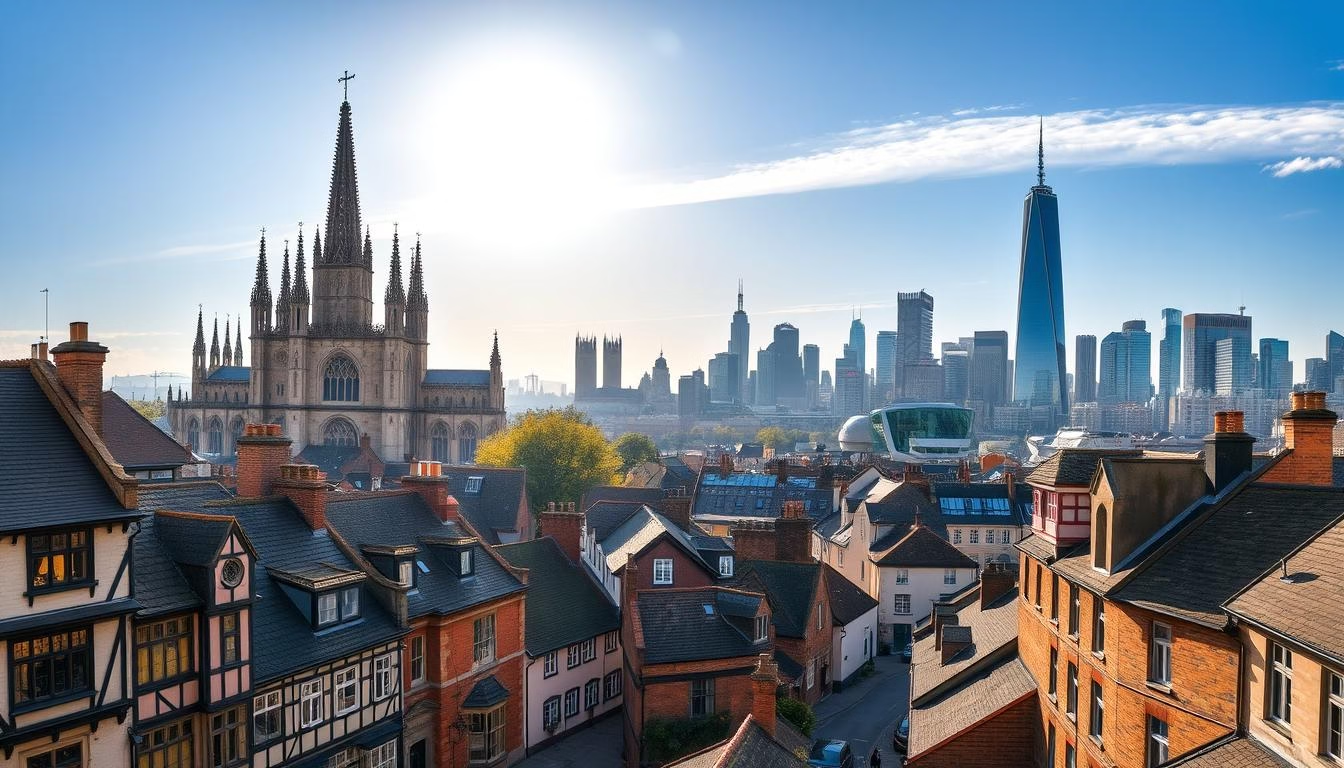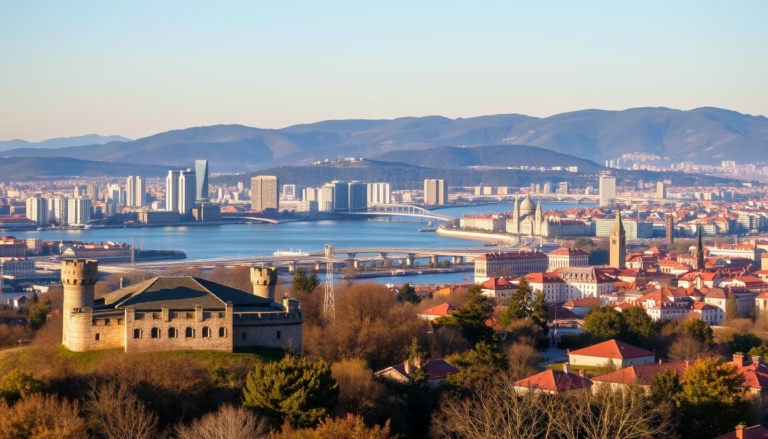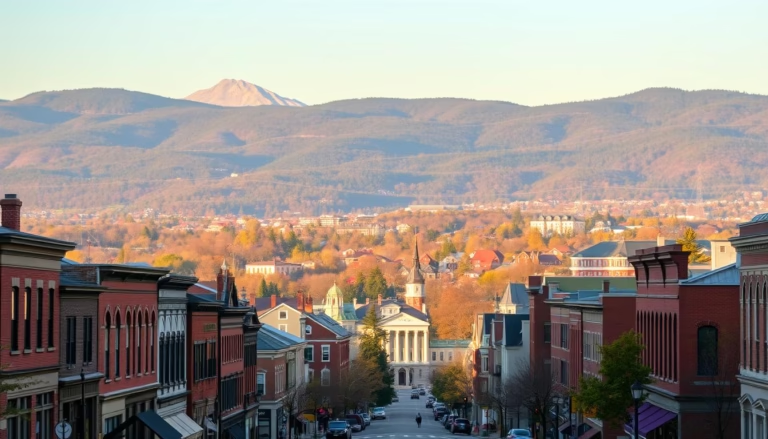Best Cities to Visit in England: Must-See Places
Did you know England packs 5,000 years of history into urban landscapes smaller than New York City? From Roman-built walls to medieval cathedrals towering over modern skylines, this island nation blends ancient wonders with cutting-edge culture.
Whether you’re drawn to cobblestone streets lined with Tudor houses or buzzing creative districts, England’s destinations surprise at every turn. Coastal towns serve fresh seafood beside Viking-era harbors, while university cities hum with youthful energy amid libraries older than the United States.
This guide reveals urban gems where you can sip tea in Georgian parlors one hour and catch underground indie bands the next. We’ll explore royal palaces turned film sets, industrial mills transformed into art spaces, and markets that’ve traded goods since Shakespeare’s time.
Key Takeaways
- England combines ancient landmarks with modern cultural scenes across its urban areas
- Coastal towns and university cities offer distinct regional flavors
- Many destinations feature UNESCO World Heritage Sites within city limits
- Historic architecture often houses contemporary restaurants and shops
- Compact city layouts make exploring multiple attractions walkable
- Seasonal events link past traditions with present-day celebrations
Introduction to England’s Timeless Urban Culture
What if you could touch ancient castle walls and attend a tech startup meetup in the same afternoon? England’s urban centers thrive as living museums, where Roman ruins sit beside vegan bakeries and Georgian townhouses hide speakeasy cocktail bars. This isn’t just sightseeing – it’s time travel with Wi-Fi.
Walk through neighborhoods where medieval cathedral spires cast shadows over glass-walled galleries displaying AI art. Cities here wear their heritage proudly – York’s Viking-age streets, Bristol’s nautical warehouses turned creative hubs, and Manchester’s textile mills reborn as music venues. Every brick tells a story, but the plot keeps twisting.
The secret sauce? Centuries of royal influence, academic breakthroughs, and global trade shaped these cultural hotspots. You’ll find Shakespeare’s Globe Theatre a tube ride away from iconic landmarks like the Tate Modern’s turbine hall. Street musicians riff on Beatles classics near pubs where Dickens once drank.
Three things make English cities unforgettable:
- Architecture that skips through time periods like a playlist shuffle
- Museums offering free passes to history’s greatest hits
- Markets where food stalls dish up global flavors beside flower sellers
Come evening, these streets transform. Lit-up castles host open-air cinemas, while jazz spills from converted churches. It’s this culture of reinvention – honoring the past while rewriting the rules – that makes England’s urban adventures endlessly surprising.
London: The Heart of Iconic Landmarks
Where else can you sip tea where queens plotted and punk rock was born? England’s capital stitches together centuries of drama and innovation. Red buses zip past Roman walls while street artists tag alleys once walked by Shakespeare.
Exploring Historic Monuments
Touch history at the Tower of London, where ravens guard crown jewels older than the United States. Watch the Changing of the Guard at Buckingham Palace – a choreographed spectacle unchanged since 1660. “London is architectural time travel,” says local historian Margaret Carter. “You’ll find Norman castles sharing postcodes with glass skyscrapers.”
Climb the 334 steps to Big Ben’s belfry for views stretching from Westminster Abbey’s Gothic spires to the Shard’s jagged peak. The city’s skyline reads like a history book – medieval, Georgian, and futuristic chapters all visible at once.
Modern Urban Experiences
Camden Market’s neon-lit stalls sell vegan treats beside vintage punk jackets. South Bank’s graffiti tunnels lead to the Tate Modern, where Warhol rubs shoulders with AI-generated art. Best part? Most museums charge £0 for their global treasures.
Grab standing tickets at the Old Vic theater, then unwind in Hyde Park’s rose gardens. As night falls, head to Soho’s speakeasies hidden behind unmarked doors – proof London’s magic often lies just out of sight.
Bath: Roman Charm and Georgian Elegance
What if you could soak in waters once cherished by Roman soldiers? Bath’s story spans over 2,000 years, blending ancient spa traditions with honey-colored Georgian townhouses that glow like amber at sunset. This UNESCO World Heritage city treats history as a living experience – sip coffee where philosophers debated thermal springs, then stroll streets Jane Austen immortalized in her novels.
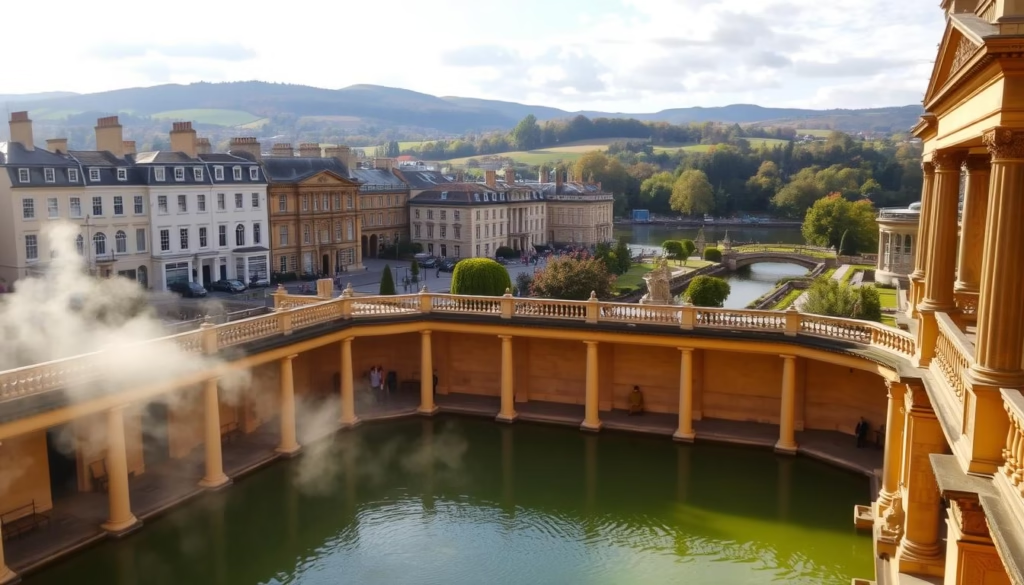
Roman Baths and Ancient History
Step into the remarkably preserved Roman Baths complex, where steaming pools and intricate stonework reveal Britain’s spa-loving past. “The sacred spring still flows at 115°F,” notes local guide Eleanor Whitmore, “just as it did when Romans built temples here in 75 AD.” Interactive exhibits let you decode Latin curses visitors etched into lead tablets centuries ago.
After exploring ancient corridors, shift eras at the Royal Crescent’s sweeping curve of Georgian townhouses. Architect John Wood the Younger’s masterpiece showcases Bath’s signature golden stone architecture, with 30 identical facades creating England’s most photographed street. Nearby, the Circus’ circular layout echoes Stonehenge’s mysterious design.
Modern visitors can still indulge in mineral-rich waters at Thermae Bath Spa’s rooftop pool. As steam rises against the city’s skyline, you’ll spot three distinct Baths: Roman ruins below, Georgian spires ahead, and 21st-century glass towers in the distance.
Don’t miss these Bath essentials:
- Afternoon tea in a Pump Room where Regency socialites once gossiped
- Novel-inspired walks through the Jane Austen Centre’s period rooms
- Dinners in converted coach houses serving Somerset cheeses and ciders
Oxford and Cambridge: Academic & Historic Wonders
Ever wondered where Nobel Prize winners debate over pints and medieval libraries host TikTok tours? England’s twin academic powerhouses blend centuries of history with youthful energy. These compact cities buzz with cyclists weaving through honey-stone archways and students debating in cafes older than some countries.
Oxford – City of Dreaming Spires
Oxford’s cobbled streets lead to hidden courtyards where 13th-century college quads meet modern art installations. The Bodleian Library’s Gothic towers hold 12 million books, while Christ Church College’s dining hall inspired Hogwarts’ Great Hall. “You can practically hear the ghosts of scholars past in these halls,” says walking tour guide Marcus Reid.
Fuel up at pubs serving ale since 1242, then explore covered markets brimming with artisan cheeses. Don’t miss the Radcliffe Camera – this circular reading room looks like a stone spaceship landed among medieval spires.
Cambridge – Riverside Punting Experience
Glide along the River Cam in flat-bottomed boats, passing weeping willows and college gardens. The Backs showcase architecture ranging from Tudor brickwork to Neoclassical facades. King’s College Chapel stuns visitors with its fan-vaulted ceiling stretching 90 feet overhead – equivalent to stacking 65 bicycles vertically.
Wander lanes dotted with independent bookshops before joining evensong at Trinity College. Evening tours reveal hidden gems like Newton’s apple tree descendant and DNA’s discovery site. Pro tip: Try strawberry ice cream from a market stall that’s operated since 1951.
Both cities offer experiences you can’t find elsewhere:
- Attend free lectures on topics from black holes to Shakespearean insults
- Hunt for vintage finds in century-old covered markets
- Picnic in botanical gardens planted during the American Revolution
Liverpool: Music, Maritime, and Modern Vibe
Where does maritime history groove to a Beatles bassline? This port city thrums with cultural energy forged by sea trade and rock ‘n’ roll rebellion. From docks that shaped global commerce to clubs that launched musical revolutions, Liverpool’s spirit shines through every brick and chord.
Where Legends Were Born
Step into the Beatles Story Museum and trace how four local lads became global icons. Interactive exhibits let you mix tracks in Abbey Road Studios and stand replica-stage at the Cavern Club. “You don’t just learn Beatles history here – you feel it in your bones,” says audio guide narrator Paul McCartney.
Waterfront Wonders
The UNESCO-listed Albert Dock blends industrial heritage with modern flair. Red-brick warehouses now house the Merseyside Maritime Museum, where exhibits reveal Liverpool’s role in transatlantic trade. Nearby, the International Slavery Museum presents powerful stories often left out of history books.
| Attraction | Highlights | Best For |
|---|---|---|
| Beatles Story | John Lennon’s glasses, Yellow Submarine booth | Music lovers |
| Albert Dock | Tate Liverpool art, waterfront dining | History buffs |
| Anfield Stadium | Liverpool FC museum, “This Is Anfield” sign | Football fans |
Feel the city’s pulse at Everton’s Goodison Park or Liverpool FC’s Anfield, where crowds roar louder than hurricane winds. Later, explore the Baltic Triangle’s underground venues keeping the music scene alive with indie bands and DJ sets.
End your day gazing at the Three Graces – neoclassical giants framing the Mersey River. Then join locals for “scouse” stew in pubs where laughter flows as freely as the ale. Here, every street corner hums with stories waiting to be heard.
Manchester: Urban Energy of Sports and Art
What fuels a city where stadium chants harmonize with gallery openings? Manchester thrums with industrial grit remixed into creative gold. Red-brick warehouses host cutting-edge art installations, while football anthems echo through streets that birthed musical revolutions.
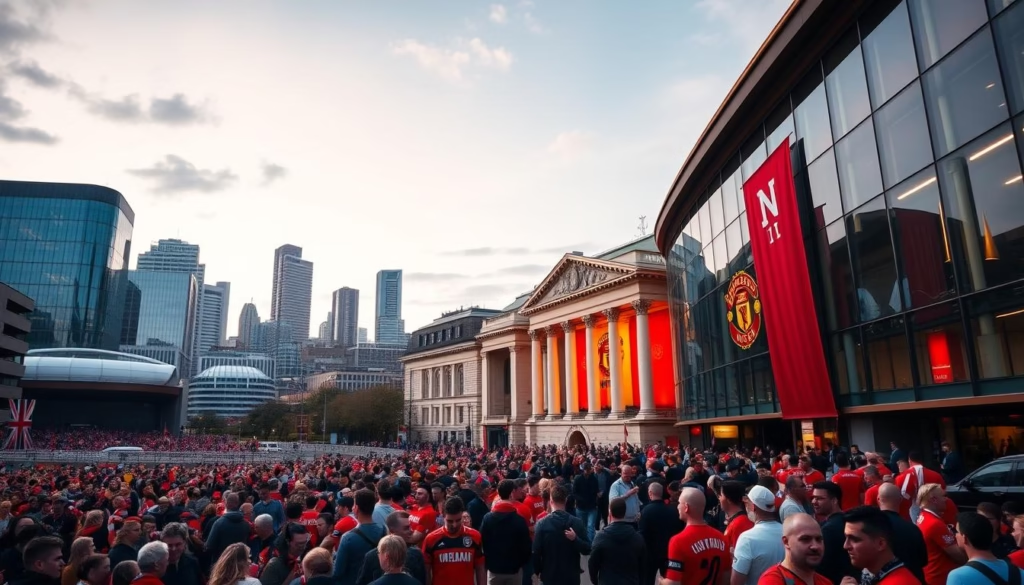
Football Passion and Creative Arts
Feel the pulse at Old Trafford, nicknamed the “Theatre of Dreams” for good reason. Tour locker rooms where legends suited up, then explore interactive exhibits detailing Manchester United’s global impact. “This isn’t just a stadium – it’s a cathedral of football,” says lifelong fan James O’Connor.
The Northern Quarter answers with its own kind of worship. Murals bloom across former textile mills housing indie record stores and espresso bars. Discover hidden gig venues where Oasis played early shows, then refuel at curry houses along Wilmslow Road’s famed strip.
Three must-do experiences reveal Manchester’s soul:
- Marvel at steam engines in the Science and Industry Museum’s railway hall
- Hunt vinyl treasures in Afflecks Palace’s labyrinth of retro shops
- Compare Renaissance masters with street art pioneers at Manchester Art Gallery
As night falls, the city shifts gears. Craft cocktail bars open in converted banks, while the Gay Village lights up with rainbow-colored energy. Whether you’re here for football glory or underground music scenes, Manchester delivers urban adventures that stick with you like a favorite chorus.
York: Walk Through Medieval History
Ever walked streets where Roman soldiers and Viking traders once roamed? York thrums with history you can touch – from 2,000-year-old fortress foundations to snickelways (hidden alleys) whispering ghost stories. This living museum lets you time-hop between eras faster than changing camera filters.
York Minster and Ancient City Walls
Gaze up at York Minster’s 235-foot central tower – taller than Niagara Falls. Its stained glass windows glow like jewel boxes, including the 600-year-old Great East Window. “Climbing the tower’s 275 steps rewards you with views stretching to the North Sea,” says cathedral guide Emily Carter.
The walls encircling the city form England’s most complete medieval defense system. Walk the 2-mile stone ribbon past Roman gates and Viking-era earthworks. Peer through arrow slits imagining 13th-century guards spotting invaders across the Yorkshire plains.
Winding Streets and Local Heritage
The Shambles’ tilting timber frames create a fairy-tale tunnel where butchers once hung meat hooks. Today, quirky shops sell magic wands and Yorkshire gin beneath these crooked buildings. Duck into snickelways like Hole-in-the-Wall – alleys so narrow you can high-five both sides.
Three experiences reveal York’s layered past:
- Jorvik Viking Centre’s ride-through dioramas of 10th-century life
- National Railway Museum’s record-breaking locomotives
- Evening ghost walks through churchyards older than the Magna Carta
Cap your day at The Shambles Tavern, where local ales flow beneath original medieval beams. As twilight paints the Minster purple, you’ll understand why York’s heritage feels more alive here than in any textbook.
Brighton: Seaside Delights and Royal Pavilion
Where can you ride a vintage carousel while debating modern art installations? Brighton’s seaside charm meets rebellious creativity just 50 minutes from London. The Palace Pier stretches into the English Channel like a glittering carnival spine – think cotton candy stands beside augmented reality exhibits.
The Royal Pavilion steals the show with its domed roof and minarets. This former royal retreat blends Indian-inspired architecture with Chinese interior designs. “It’s like a maharaja’s palace crash-landed in Sussex,” locals joke. Twilight tours reveal dragon carvings glowing under colored lights.
Wander The Lanes’ maze of narrow alleys packed with vegan bakeries and vinyl record shops. You’ll find tattoo parlors next to antique stores selling 18th-century teacups. Don’t miss the UK’s largest queer-friendly scene buzzing in bars where drag queens host bingo nights.
Three essentials define this city:
– Fish-and-chips devoured on pebble beaches
– Secret speakeasies hidden behind unmarked doors
– Sunset views from the i360 observation tower
Brighton thrives on contradictions. Victorian bathhouses host yoga retreats, while street artists tag murals celebrating the Royal Pavilion’s legacy. Whether you’re here for the seaside breeze or underground comedy clubs, the city delivers an experience as refreshing as a dip in the Channel.
